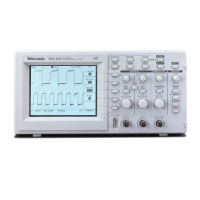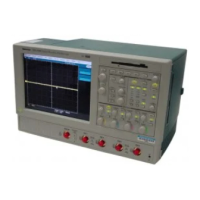Pinpoint Trigge
rs
Pinpoint Triggers
The Pinpoint trigger system also comes with a robust suite of advanced trigger types that is usable on both A and B
triggers, and it adds Reset capability to reset the trigger sequence if the B event does not occur after a specific number of
events or a specific time. Together, these features support capture of events based on the most complex trigger event or
sequence of trigger events.
This section contains concepts and procedures for using the trigger system. Detailed information is available in the
online help.
Triggering Concepts
Trigger Event
The trigger event establishes the time-zero point in the waveform record. All waveform record data are located in time with
respect to that point. The instrument continuously acquires and retains enough sample points to fill the pretrigger portion of
the waveform record (that part of the waveform that is displayed before, or to the left of, the triggering event on screen).
When a trigger event occurs, the instrument starts acquiring samples to build the posttrigger portion of the waveform record
(displayed after, or to the right of, the trigger event). Once a trigger is recognized, the instrument will not accept another
trigger until the acquisition is complete and the holdoff time has expired.
Trigger Types
Edge trigge
rs are the simplest and most commonly used trigger type, used with both analog and digital signals. An edge
trigger event occurs when the trigger source passes through a specified voltage level in the specified direction (rising
or falling signal voltage).
Pulse triggers are special-purpose triggers that are primarily used with digital signals. The following types of pulse triggers
are availa
ble: Glitch, Runt, Window, Width, Transition, and Timeout.
Logic trig
gers are special-purpose triggers that are primarily used with digital logic signals. Two of the types, Pattern and
State, trigger the instrument based on the Boolean operator you select for the trigger sources. A third type, Setup and Hold,
triggers when Data on one trigger source changes state within the setup and hold times that you specify relative to a
Clock on a
nother trigger source.
Communic
ation triggers (available only with Option SM) are used on communication signals. Mask testing automatically
uses Communication triggers.
The serial pattern trigger (available with Option ST) is a special trigger type used on signals with serial data patterns. Serial
triggering is available with A triggers only, and only when the Serial option is present.
Trigger M
odes
The trigger mode determines how the instrument behaves in the absence of a trigger event:
Normal trigger mode enables the instrument to acquire a waveform only when it is tr iggered. If no trigger occurs, the last
waveform record acquired remains on the display. If no last waveform exists, no waveform is displayed.
Auto trigger mode enables the instrument to acquire a waveform even if a trigger does not occur. Auto m ode uses a timer
that starts after a trigger event occurs. If another trigger event is not detected before the timer times out, the instrument
forces a trigger. The length of time it waits for a trigger event depends on the time base setting.
28 TDS6000B & TDS6000C Series Quick Start User Manual

